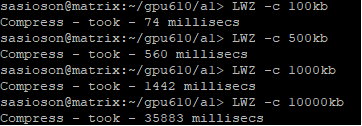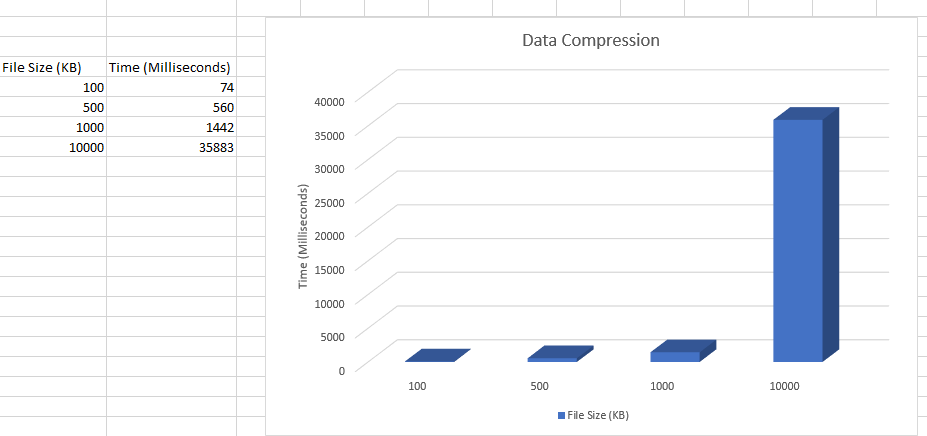Difference between revisions of "Kernal Blas"
(→Data Compression) |
(→Assignment 1) |
||
| Line 70: | Line 70: | ||
The compress dictionary copies the file into a new file with a .LZW filetype which uses ASCII | The compress dictionary copies the file into a new file with a .LZW filetype which uses ASCII | ||
| − | The function that compresses the file initializing with ASCII | + | '''The function that compresses the file initializing with ASCII |
| + | <syntaxhighlight lang="cpp"> | ||
| + | |||
| + | void compress(string input, int size, string filename) { | ||
| + | unordered_map<string, int> compress_dictionary(MAX_DEF); | ||
| + | //Dictionary initializing with ASCII | ||
| + | for (int unsigned i = 0; i < 256; i++) { | ||
| + | compress_dictionary[string(1, i)] = i; | ||
| + | } | ||
| + | string current_string; | ||
| + | unsigned int code; | ||
| + | unsigned int next_code = 256; | ||
| + | //Output file for compressed data | ||
| + | ofstream outputFile; | ||
| + | outputFile.open(filename + ".lzw"); | ||
| + | |||
| + | for (char& c : input) { | ||
| + | current_string = current_string + c; | ||
| + | if (compress_dictionary.find(current_string) == compress_dictionary.end()) { | ||
| + | if (next_code <= MAX_DEF) | ||
| + | compress_dictionary.insert(make_pair(current_string, next_code++)); | ||
| + | current_string.erase(current_string.size() - 1); | ||
| + | outputFile << convert_int_to_bin(compress_dictionary[current_string]); | ||
| + | current_string = c; | ||
| + | } | ||
| + | } | ||
| + | if (current_string.size()) | ||
| + | outputFile << convert_int_to_bin(compress_dictionary[current_string]); | ||
| + | outputFile.close(); | ||
| + | } | ||
| + | |||
| + | </syntaxhighlight> | ||
| Line 78: | Line 109: | ||
| − | [[File:Compression_test.png | + | [[File:Compression_test.png]] |
| + | |||
| + | |||
| + | |||
| + | [[File:Compression_test_chart.png]] | ||
| + | |||
| + | |||
| + | '''Parallelizing | ||
| + | |||
| + | From one of the suggested improvements in the algorithm post link. A potential improvement is changing from char& c to a const char in the for loop | ||
| + | |||
| + | <syntaxhighlight lang="cpp"> | ||
| + | for (char& c : input) { | ||
| + | </syntaxhighlight > | ||
| − | + | since char& c is not being modified. | |
=== Assignment 2 === | === Assignment 2 === | ||
=== Assignment 3 === | === Assignment 3 === | ||
Revision as of 17:54, 24 February 2018
GPU610/DPS915 | Student List | Group and Project Index | Student Resources | Glossary
Contents
Kernal Blas
Team Members
Progress
Assignment 1
Calculation of Pi
For this assessment, we used code found at helloacm.com
In this version, the value of PI is calculated using the Monte Carlo method. This method states:
- A circle with radius r in a squre with side length 2r
- The area of the circle is Πr2 and the area of the square is 4r2
- The ratio of the area of the circle to the area of the square is: Πr2 / 4r2 = Π / 4
- If you randomly generate N points inside the square, approximately N * Π / 4 of those points (M) should fall inside the circle.
- Π is then approximated as:
- N * Π / 4 = M
- Π / 4 = M / N
- Π = 4 * M / N
For simplicity the radius of the circle is 1. With this, we randomly generate points within the area and count the number of times each point falls within the circle, between 0 and 1. We then calculate the ratio and multiply by 4 which will give us the approximation of Π.
When we run the program we see:
1st Run
1000 3.152 - took - 0 millisecs 10000 3.1328 - took - 0 millisecs 100000 3.14744 - took - 9 millisecs 1000000 3.141028 - took - 96 millisecs 10000000 3.1417368 - took - 998 millisecs 100000000 3.1419176 - took - 10035 millisecs The first column represents the "stride" or the number of digits of pi we are calculating to.
With this method, we can see that the accuracy of the calculation is slightly off. This is due to the randomization of points within the circle. Running the program again will give us slightly different results.
2nd Run
1000 3.12 - took - 0 millisecs 10000 3.1428 - took - 0 millisecs 100000 3.13528 - took - 9 millisecs 1000000 3.143348 - took - 106 millisecs 10000000 3.1414228 - took - 1061 millisecs 100000000 3.14140056 - took - 8281 millisecs
The hotspot within the code lies in the loops. There iteration for the loops is O(n2)
Potential Speedup:
Using Gustafson's Law:
P = 50% of the code P = 0.50 n = ? S(n)= n - ( 1 - P ) ∙ ( n - 1 ) Sn = n - ( 1 - .5 ) ∙ ( n - 1 ) Sn =
Data Compression
For this suggested project we used the LZW algorithm from one of the suggested projects.
The compress dictionary copies the file into a new file with a .LZW filetype which uses ASCII
The function that compresses the file initializing with ASCII
void compress(string input, int size, string filename) {
unordered_map<string, int> compress_dictionary(MAX_DEF);
//Dictionary initializing with ASCII
for (int unsigned i = 0; i < 256; i++) {
compress_dictionary[string(1, i)] = i;
}
string current_string;
unsigned int code;
unsigned int next_code = 256;
//Output file for compressed data
ofstream outputFile;
outputFile.open(filename + ".lzw");
for (char& c : input) {
current_string = current_string + c;
if (compress_dictionary.find(current_string) == compress_dictionary.end()) {
if (next_code <= MAX_DEF)
compress_dictionary.insert(make_pair(current_string, next_code++));
current_string.erase(current_string.size() - 1);
outputFile << convert_int_to_bin(compress_dictionary[current_string]);
current_string = c;
}
}
if (current_string.size())
outputFile << convert_int_to_bin(compress_dictionary[current_string]);
outputFile.close();
}
The results of the compression from:
Parallelizing
From one of the suggested improvements in the algorithm post link. A potential improvement is changing from char& c to a const char in the for loop
for (char& c : input) {since char& c is not being modified.

